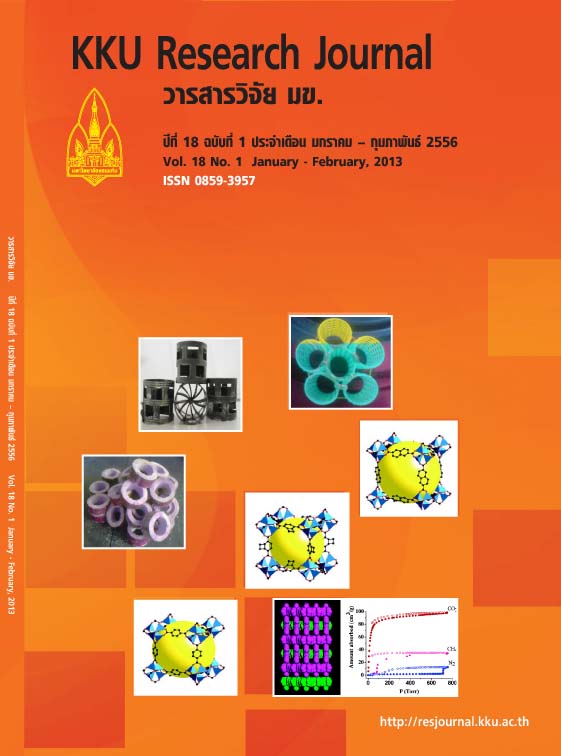High frequency callus induction through anther culture in high oil sunflower (Helianthus annuus L.)
Main Article Content
Abstract
Anther culture is one of the popular methods for pure line production in a short time, but its success depends on medium composition and culture environment. This research aimed to determine a suitable medium and the optimal culture condition for high callus induction from anthers of high oil sunflower. The anthers of two sunflower varieties, 9B and 12B, in the R5.1 stage were cultured on modified MS media, A1-A5, in light and dark conditions for 21 days. The results showed that callus formation was only observed from medium supplemented with plant growth regulators. Significant differences were observed among genotypes as well as culture media in respect of callus induction. However, light did not significantly affect callus induction and size but slight greening of calli was observed at 21 days after culture which can be further developed into embryogenic calli. The variety 9B showed higher callus induction percentage (23.75% to 99%) than variety 12B (9% to 26.25%). Result also showed that A5 medium under the light condition was the best medium to induce the highest callus formation of variety 9B (99%). The rate of success could be enhanced by improving the composition of culture medium, especially by manipulating plant growth regulators and CH. Five different modified MS media, B1-B5, under light condition were further tested for callus induction. The highest percentage of callus formation was achieved with B3 medium containing 500 mg/l CH, 2 mg/l NAA and 1 mg/l BAP followed by B5 and B2 which were 100, 97.5 and 87.5%, respectively.
Article Details
References
[2] Dunwell JM. Plant cell culture: A practical approach. Dixon RA, editor. Oxford; 1985.
[3] Saisingtong S. In vitro regeneration of double haploid maize (Zea mays L.) plant [PhD thesis]. Institute of Plant Sciences of the Swiss Federal Institute of Technology (ETH). Switzerland; 1998.
[4] Kaveeta R. Plant tissue culture. Kasetsart University Press. Bangkok; 1997. Thai.
[5] Bajaj YS. In vitro production of haploids. In: Evans DA, Sharp WR, Ammirato PV, Yamada Y, editors. Handbook of Plant cell culture. Macmillan. New York; 1983. p. 228-287.
[6] White PR. Potentially unlimited growth of excised tomato root tips in a liquid medium. Plant Physiol. 1943; 9: 585.
[7] Murashige T, Skoog F. A revised medium for rapid growth and bioassay with tobacco tissue culture. Plant Physiol. 1962;15: 473-497.
[8] Nitsch JP, Nitsch C. Haploid plant from pollen grains. Science. 1969; 163: 85-87.
[9] Bajaj YS. In vitro production of haploids and their use in cell genetics and plant breeding. In: Bajaj YS, editor. Biotechnology in Agriculture and Forestry. Berlin; 1990. p. 3-48.
[10] Nurhidayah T, Renate H, Thomas R, Wolfgang F. High regeneration rates in anther culture of interspecifi c sunfl ower hybrids. Plant Cell Rep. 1996; 16: 167-173.
[11] Laosuwan P, Machikowa T. Synthetic Sunfl ower Breeding for High Oil Content. Sunflower Development Project, Phase II. Suranaree University. Nakhon Ratchasima; 2007.
[12] Schneiter AA, Miller JF. Description of sunfl ower growth stages. Crop Sci. 1993; 21: 901-903.
[13] Levesque R. SPSS Programming and Data Management, 3rd ed. SPSS Institute. United State of America; 2006.
[14] Saji KV, Sujatha M. Embryogenesis and plant regeneration in anther culture of sunflower (Helianthus annuus L.). Euphytica. 1998; 103: 1-7.
[15] Pimaiklang L. Factors influencing marigold (Tagetes erecta Linn.) anther grown in vitro [MSc thesis]. Chiang Mai: Chiang Mai University; 1996.Thai.
[16] Priya V, Sassikumar K, Sudhagar DR, Gopalan A. Androgenetic response of sunfl ower in different culture environments. Helia. 2003; 38: 39-50.
[17] Thengane SR, Joshi MS, Khuspe SS, Mascarenhas AF. Anther culture in Helianthus annuus L., infl uence of genotype and culture conditions on embryo induction and plant regeneration. Plant Cell Rep. 1994; 13: 222-226.
[18] Seabrook JE. Laboratory culture. In: Staba EJ, editors. Plant tissue culture as a source of biochemical. CRC Press: Florida; 1980.
[19] Vongverachai C. The effects of 2,4-D and kinetin on callus production of some medicinal herbs [MSc thesis]. Chiang Mai: Chiang Mai University; 1985.Thai.
[20] Boxus PH, Quoirin M, Laine JM. Large scale propagation of strawberry plant from tissue culture. In: Reinert J, Bajaj YS, editors. Plant cell tissue and organ culture. Springer-Verlag. Berlin, Heidelberg; 1977. p. 130-143.
[21] Yamada Y. Tissue culture studies on cereals. In: Reinert J, Bajaj YS, editors. Plant cell tissue and organ culture. Springer-Verlag. Berlin, Heidelberg; 1977. p. 144-159.
[22] Allavena A. Beans (Phaseolus) In: Scharp WR, editors. Hand book of Plant Cell Culture. Macmillan Publishing Company. New York; 1984. p. 47-68.
[23] Sawhney RW, Galston AW. Oats. In: Scharp WR, editors. Handbook of Plant Cell Culture. Macmillan Publishing Company. New York; 1984. p. 6-44.


